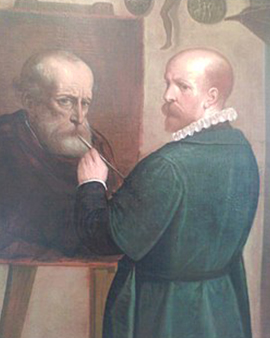Luca Cambiaso, a captivating master of the Renaissance, was born in Moneglia on November 18, 1527, and left the world a dazzling array of artworks that show a deep study of human nature and a remarkable ability to depict calm sensations. From a young age he showed remarkable mechanical skill and an impressive wealth of ideas, a gift that awakened in him under the tutelage of his father, the painter Giovanni Cambiaso. The times when he acquired his first brushstrokes under his father's watchful eye can be seen today in every art print of his work, testifying to the fundamental role his father played in his artistic career.
Throughout his career, Cambiaso went beyond traditional boundaries and sought inspiration in the work of other masters, including Raffaello Sanzio Raphael and Michelangelo. His dedication to the study of nature, grace and a pleasing coloration, in which Antonio da Correggio seemed to float, helped shape his artistic identity and molded him into one of the most outstanding painters of his time. His works, reproduced today in the form of high-quality art prints, act as fresh springs in a mannered era and carry a refreshing innocence that underscores their timeless beauty. Cambiaso's talent extended far beyond the panel painting format. One of his most outstanding skills was creating frescoes for churches and palaces in Genoa, a city fortunate to house most of his works. His ability to evoke emotion and create carefully considered compositions helped make his works Renaissance masterpieces. Each art print created based on his works shows not only his remarkable skills, but also his deep understanding of form and color.
Toward the end of his career, Cambiaso showed a fascinating penchant for reducing constellations of people to basic geometric shapes, an approach that gives his sketches an almost cubist feel. Although there is a certain ephemerality to his later work, his artistic legacy remains undisputed, and his works still exude an irresistible fascination today. An art print of his work is not only a tribute to his remarkable contribution to art, but also a reminder of his artistic brilliance, which continues to be marveled at in the art world today.
×





.jpg)
.jpg)
.jpg)
.jpg)
_-_(MeisterDrucke-1662869).jpg)
_-_(MeisterDrucke-1662869).jpg)
.jpg)
.jpg)
.jpg)
.jpg)
.jpg)
.jpg)
.jpg)
.jpg)
.jpg)
.jpg)
.jpg)
.jpg)
_sacristy_chapel_Angels_with_episcopal_insign_-_(MeisterDrucke-1409733).jpg)
_sacristy_chapel_Angels_with_episcopal_insign_-_(MeisterDrucke-1409733).jpg)
_-_(MeisterDrucke-1663210).jpg)
_-_(MeisterDrucke-1663210).jpg)
_inside_The_Lercari_Chapel_or_The_Chapel_of_t_-_(MeisterDrucke-1399638).jpg)
_inside_The_Lercari_Chapel_or_The_Chapel_of_t_-_(MeisterDrucke-1399638).jpg)
.jpg)
.jpg)
.jpg)
.jpg)
_oil_on_canvas_-_(MeisterDrucke-1120078).jpg)
_oil_on_canvas_-_(MeisterDrucke-1120078).jpg)
_by_Luca_Cambiaso_(1527-1585)_fresco_Vill_-_(MeisterDrucke-1422757).jpg)
_by_Luca_Cambiaso_(1527-1585)_fresco_Vill_-_(MeisterDrucke-1422757).jpg)
_dit_Lucchetto_-_(MeisterDrucke-1318134).jpg)
_dit_Lucchetto_-_(MeisterDrucke-1318134).jpg)
_-_(MeisterDrucke-1459801).jpg)
_-_(MeisterDrucke-1459801).jpg)
_-_(MeisterDrucke-1662959).jpg)
_-_(MeisterDrucke-1662959).jpg)
_-_(MeisterDrucke-1362877).jpg)
_-_(MeisterDrucke-1362877).jpg)
.jpg)
.jpg)
_ceiling_of_Salone_Cambiaso_-_(MeisterDrucke-1062067).jpg)
_ceiling_of_Salone_Cambiaso_-_(MeisterDrucke-1062067).jpg)
_inside_Baptistery_(formerly_Church_of_St_Joh_-_(MeisterDrucke-1399641).jpg)
_inside_Baptistery_(formerly_Church_of_St_Joh_-_(MeisterDrucke-1399641).jpg)
.jpg)
.jpg)
_St_Gotthard_between_St_Paul_and_St_James_and_-_(MeisterDrucke-1409671).jpg)
_St_Gotthard_between_St_Paul_and_St_James_and_-_(MeisterDrucke-1409671).jpg)
.jpg)
.jpg)
.jpg)
.jpg)
_inside_Baptistery_(formerly_Church_of_St_Joh_-_(MeisterDrucke-1411966).jpg)
_inside_Baptistery_(formerly_Church_of_St_Joh_-_(MeisterDrucke-1411966).jpg)
_-_(MeisterDrucke-1109902).jpg)
_-_(MeisterDrucke-1109902).jpg)
.jpg)
.jpg)
.jpg)
.jpg)
_Dim_-_(MeisterDrucke-1029262).jpg)
_Dim_-_(MeisterDrucke-1029262).jpg)
.jpg)
.jpg)
.jpg)
.jpg)
.jpg)
.jpg)
.jpg)
.jpg)
.jpg)
.jpg)
.jpg)
.jpg)
.jpg)
.jpg)
.jpg)
.jpg)
.jpg)
.jpg)
.jpg)
.jpg)
_16th_century_Genes_Musei_-_(MeisterDrucke-1029241).jpg)
_16th_century_Genes_Musei_-_(MeisterDrucke-1029241).jpg)
.jpg)
.jpg)
.jpg)
.jpg)
.jpg)
.jpg)
_by_Luca_Cambiaso_(1527-1585)_fresco_Villa_Impe_-_(MeisterDrucke-1109293).jpg)
_by_Luca_Cambiaso_(1527-1585)_fresco_Villa_Impe_-_(MeisterDrucke-1109293).jpg)
.jpg)
.jpg)
.jpg)
.jpg)
.jpg)
.jpg)
.jpg)
.jpg)
_-_(MeisterDrucke-803266).jpg)
_-_(MeisterDrucke-803266).jpg)
_by_Luca_Cambiaso_(1527-1585)_fresco_Villa_Impe_-_(MeisterDrucke-1422486).jpg)
_by_Luca_Cambiaso_(1527-1585)_fresco_Villa_Impe_-_(MeisterDrucke-1422486).jpg)
.jpg)
.jpg)
_oil_on_canvas_-_(MeisterDrucke-1117598).jpg)
_oil_on_canvas_-_(MeisterDrucke-1117598).jpg)
.jpg)
.jpg)
_inside_The_Lercari_Chapel_or_The_Chapel_of_t_-_(MeisterDrucke-1402193).jpg)
_inside_The_Lercari_Chapel_or_The_Chapel_of_t_-_(MeisterDrucke-1402193).jpg)
_-_(MeisterDrucke-1421400).jpg)
_-_(MeisterDrucke-1421400).jpg)
.jpg)
.jpg)
.jpg)
.jpg)
.jpg)
.jpg)
.jpg)
.jpg)
.jpg)
.jpg)
.jpg)
.jpg)
.jpg)
.jpg)
.jpg)
.jpg)
.jpg)
.jpg)
.jpg)
.jpg)
_-_(MeisterDrucke-1123359).jpg)
_-_(MeisterDrucke-1123359).jpg)
_-_(MeisterDrucke-1062454).jpg)
_-_(MeisterDrucke-1062454).jpg)
_-_(MeisterDrucke-1460425).jpg)
_-_(MeisterDrucke-1460425).jpg)
.jpg)
.jpg)
.jpg)
.jpg)
.jpg)
.jpg)
.jpg)
.jpg)
_ceiling_of_Salone_Cambiaso_-_(MeisterDrucke-1062066).jpg)
_ceiling_of_Salone_Cambiaso_-_(MeisterDrucke-1062066).jpg)
.jpg)
.jpg)
.jpg)
.jpg)
_with_Book_-_(MeisterDrucke-1296651).jpg)
_with_Book_-_(MeisterDrucke-1296651).jpg)
.jpg)
.jpg)
_Painting_by_Luca_Cambiaso_-_(MeisterDrucke-970588).jpg)
_Painting_by_Luca_Cambiaso_-_(MeisterDrucke-970588).jpg)
_-_(MeisterDrucke-1315421).jpg)
_-_(MeisterDrucke-1315421).jpg)
.jpg)
.jpg)
.jpg)
.jpg)
.jpg)
.jpg)
.jpg)
.jpg)
.jpg)
.jpg)
.jpg)
.jpg)
.jpg)
.jpg)
.jpg)
.jpg)
.jpg)
.jpg)
.jpg)
.jpg)
.jpg)
.jpg)
.jpg)
.jpg)
_-_(MeisterDrucke-1099714).jpg)
_-_(MeisterDrucke-1099714).jpg)
.jpg)
.jpg)
_Drawing_in_pen_and_gou_-_(MeisterDrucke-1111668).jpg)
_Drawing_in_pen_and_gou_-_(MeisterDrucke-1111668).jpg)
.jpg)
.jpg)
.jpg)
.jpg)
.jpg)
.jpg)






